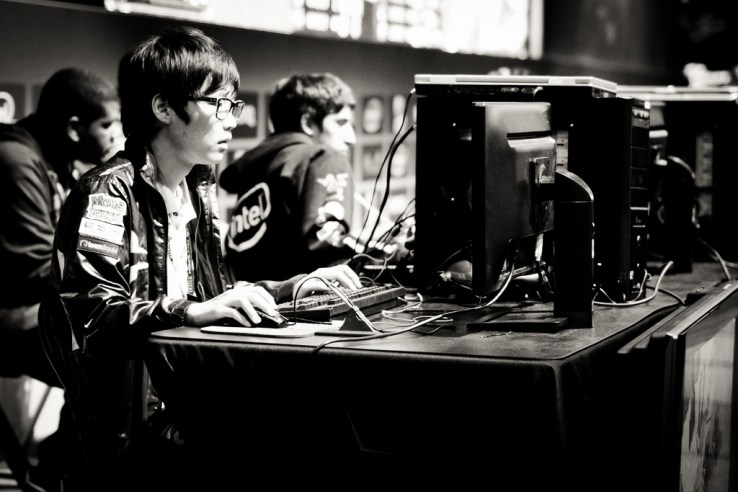Tech companies and the global rise of e-sports – TechCrunch

The latest sports phenomenon sweeping the globe wasn’t represented at the Olympic Games in Rio; it doesn’t require an intense physical training regimen or even traditional sports equipment. We’re talking about e-sports — competitive video gaming — and the opportunities for huge windfalls for players and advertisers are immense. Corporations plan to spend $325 million on sponsorships and marketing of e-sports this year, hoping to reach gaming’s huge millennial demographic as the sport goes viral.
The idea of publicizing video game competitions is nothing new. In 1972, Stanford University invited students to an “Intergalactic Spacewar Olympics” for the game Spacewar. The prize? A year’s subscription to Rolling Stone magazine. These days, prize pools for major competitions, like Call of Duty, are at least in the six-figure range, and crowdfunded prize pools boost those paychecks into the millions.
Beyond advertisers and gamers, the real money up for grabs here is for the tech companies that can successfully bring these competitions to a worldwide audience in a mainstream media format. With the industry projected to generate more than $1.9 billion in revenue by 2018, there are various rising tech players to watch as this fierce competition heats up.
Recently emerged from stealth mode, startup Genvid Technologies has the lofty goal of creating “revolutionary eSports broadcasts.” By bringing interactive elements and multiple camera angles into live-streamed games, co-founder Jacob Navok hopes to hook a whole new audience with more compelling broadcasts and greater opportunities to monetize competitions.
The challenge is that video games are built with players, rather than spectators, in mind. Genvid hopes to solve this problem by enabling developers to control camera angles during live-streamed games as if they were in the editing booth at major sporting events. This would create a more compelling narrative with built-in storytelling and emotion — something that would be appealing to sponsors, advertisers and viewers.
Genvid hopes to challenge Twitch, the leading streaming platform for e-sports, which has a staggering 45 million monthly viewers. Twitch’s single-camera perspective, Novak says, is like “watching a Major League Baseball game from the viewpoint of a GoPro camera strapped to a player’s back.” It’s pretty easy to see the huge potential for profit if Genvid is successful with its current free demo phase and upcoming beta tests with e-sports companies.
ESPN performed some unexpectedly successful beta testing of its own last June when it became the first sports magazine to dedicate an entire issue to e-sports. One of the issue’s featured stories on a top gamer received more than 1.1 million page views on ESPN.com. Realizing professional coverage of this burgeoning arena would have a huge instant audience, ESPN launched a dedicated e-sports vertical this year. ESPN2 even televised an entire live competition called Heroes of the Dorm last year. We can expect to see the sports juggernaut roll out even more coverage of e-sports in coming months.
We can’t have a conversation about e-sports without discussing its mobile applications. An app that improves the players, not the game? Germany’s got that. Technology is making it even easier for aspiring players looking to cash in on the huge prizes available to top gamers with Dojo Madness, a Berlin-based startup with plans to turn gamers’ smartphones into an e-sports coach. Through advances that combine machine learning with in-play data, Dojo Madness has created a coaching app that raised $4.5 million in its first round of funding. Initially targeting League of Legends, the app offers strategy before and during the game, and analyzes performance in a post-game recap.
This second-screen technology will be huge in the age of big data. League of Legends, among other games, offers open APIs, enabling e-sports companies to pull in gameplay data, which in turn makes in-game coaching possible. The company’s League of Legends app, called LOLSumo, is already the top app for this game, with more than half a million downloads.
Another big player capitalizing in the e-sports area is Activision, a company hoping to “activize” more cash in their cache. Earlier this year, in a $46 million deal, Activision Blizzard acquired Major League Gaming, an early organizer of e-sports competitions. Valued at $27 billion, Activision is already a leader in the industry as the publisher of leading franchises, such as Call of Duty, but this move signals that they want more than the game — Activision wants to dominate the entire arena of e-sports.
According to chief executive Robert Kotick, Activision hopes to create “the ESPN of eSports” by bringing mainstream viewing away from the internet and onto traditional cable TV channels. This could be tough competition, as ESPN still intends to be the ESPN of e-sports — may the best company win!
Kotick hopes to tap into an even bigger audience than the online community by bolstering televised broadcasts with the same kind of coverage that traditional sports receive. In the spirit of the Games, Activision and Genvid Technologies should play on the same team instead of as opponents.
The budding startups, big tech companies and TV channels planning to capitalize on e-sports are just the beginning of the sport’s global rise. The International e-Sports Federation (IeSF) even took steps to be recognized by the Olympic Committee in February, and was provided the necessary route to become an official sport in April. Indeed, e-sports could be on the Olympic stage before we know it — but until then, there will be no shortage of players getting their heads and wallets in the game.



